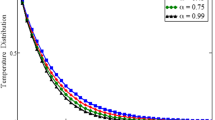Abstract
Gas particulate boundary layer equations with no pressure gradient are computed numerically in the physical plane by a Crank-Nicholson scheme of finite differences. Results so obtained are compared with the approximate method of Tabakoff and Hamed. The present analysis gives accurate description of the structure of the boundary layer of the gas particulate flow. A parametric study giving the effect of the changes in the non-dimensional parameter\(\bar F\) on the various characteristics of the flow is also carried out.
Similar content being viewed by others
References
Jain A C and Ghosh A 1979Z. Flugwiss Weltraumforchung Band3, Heft 1, pp. 29–37
Marbla F E 1963Combustion and propulsion. Fifth AGARD Colloquim (Brauchwaiq April 9–13), Pergamon Press
Singleton R E 1965Z. Angew. Math. Phys. 16 421
Soo S L 1968Z. Angew. Math. Phys. 19 545
Soo S L 1967Fluid dynamics of multiphase systems (Massachusetts: Blaisdell)
Tabakoff W and Hamed A 1972Z. Flugwiss 10 373
Author information
Authors and Affiliations
Rights and permissions
About this article
Cite this article
Prabha, S., Jain, A.C. Laminar boundary layer of gas particulate flow on a flat plate. Proc. Indian Acad. Sci. (Math. Sci.) 88, 377–385 (1979). https://doi.org/10.1007/BF03047133
Received:
Revised:
Issue Date:
DOI: https://doi.org/10.1007/BF03047133




